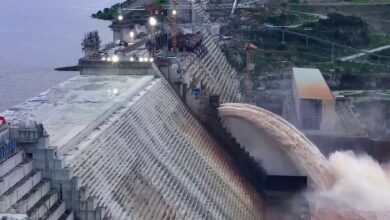Silt and floods stop Ethiopian Renaissance Dam turbines

Despite the Ethiopian authorities’ announcement that they are seeking to complete the construction of the Renaissance Dam in less than two years, explaining that they are operating the rest of the turbine in the dam and preparing for the fourth filling, a recent photo taken Wednesday confirmed the opposite by decommissioning the turbine.
Egyptian expert Dr. Abbas Sharaki revealed in a press release that space images showed the continued interruption of Ethiopia’s two turbines more than a month ago due, inter alia, to severe flooding, frequent sediment and impurities from plant and tree residues that hamper operating traffic as well as silt with no strong power transmission network.
Unprecedented discharge of dam water
The Damazin scale on the Sudanese-Ethiopian border recorded an unprecedented disposal of the Renaissance Dam’s waters in September in the last two years, reaching 614 million m3, an increase of 108 million m3 over the same day last year.
The month of September recorded a significant rise in rainfall of about 42% and higher than the average rain in September 2021, which was also about 32%.
The end of the third filling and an Egyptian warning
Last August, Ethiopian authorities announced the end of the third filling of the Renaissance Dam, storing up to 22 billion cubic metres and passing water through the Dam’s central corridor.
Ethiopian Prime Minister Abiy Ahmed said at the time that the dam’s height had reached 600 metres.
The Egyptian Ministry of Foreign Affairs had affirmed in a letter to the Security Council that Ethiopia’s conduct was an express violation of the 2015 Declaration of Principles Agreement and a grave violation of applicable rules of international law that obliged Addis Ababa as a State of origin not to prejudice the rights of downstream States.
Egypt will not tolerate any infringement of its rights, water security or any threat to the capabilities of the Egyptian people, whose only lifeline is the Nile River.





